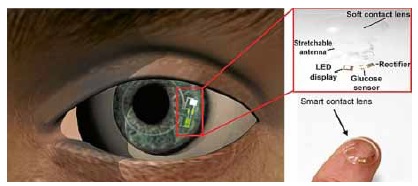
The internet was once again flooded with stories last week on how technology will soon change the way diabetics monitor blood glucose. A group of Korean scientists developed a contact lens that allows diabetics to monitor their blood sugar.
This development hopes to someday eliminate the need for diabetics to test their blood with a glucose meter. Many diabetic patients have to prick their fingers several times every day or insert a needle under the skin—both painful and cumbersome methods, although absolutely necessary for controlling blood sugar.
There have been previous attempts to embed glucose monitors in contact lenses. One prominent tech company, Google, announced in 2014 it was developing a lens capable of measuring blood sugar levels using a wireless chip and minisensor.
Uncomfortable
The first lens, however, required rigid electronics to be embedded into the lens, resulting in a device that was both uncomfortable and prone to breaking, said lead study author Jang-Ung Park, a professor of engineering at Ulsan National Institute of Science & Technology in South Korea, in a paper published in the journal Science Advances.
Park and his team refined the old model with electrodes made of highly stretchable and transparent materials that make the lens easier to wear. The wireless display has a LED pixel that detects fluctuating glucose levels while displaying the information at the same time. There’s an embedded wireless antenna in the sensor so that patients can transmit their health data, allowing real-time monitoring.
The device has so far been tested only on rabbits, who never showed discomfort while wearing the lens. The embedded electronics, including a little LED light and a glucose sensor, alerts the wearers with a flickering light, should glucose levels rise.
During the trial on the rabbits, the LED stayed on until the researchers squirted a glucose solution into the rabbit’s eye.
While its developers believe these smart lenses may be commercially available for people in less than five years—to be placed in one eye, and not to be used to correct vision—so far it hasn’t been tested in humans or with human tears.
John L. Smith, former chief scientific officer of Johnson & Johnson’s glucose monitoring division and author of “The Pursuit of Noninvasive Glucose: Hunting the Deceitful Turkey,” told The Verge that while the circuitry on a flexible contact lens is impressive, the glucose readings from tears do not reflect the levels in blood reliably enough to guide treatment decisions for people with diabetes.
Unreliable?
“It’s an unreliable measure of blood glucose. And that’s something you have to measure with great reliability or you will expose people to harm,” Smith told The Verge. Tears, he said, just don’t track levels of glucose in the blood closely enough to be used for monitoring.
In a paper published in the British Journal of Ophthalmology in 1980 (“Tear Glucose Levels in Normal People and in Diabetic Patients,” by D.K. Sen and G.S. Sarin), where 100 people were tested, “No significant correlation was found between the glucose level of blood and tears.”
Live Science also reported that many techniques have already been developed through the years to measure glucose in tears, but these measurements are usually not accurate for a variety of factors. Glucose concentrations can be lower when the eyes are more watery from allergies or from crying, for example.
“Tear glucose levels do vary in relation to blood glucose levels, so much research still needs to be done to clarify the correlation and how closely tear glucose levels track with blood glucose levels,” Matt Petersen, managing director of medical information for the ADA, told Live Science.
Developers of the new smart lenses, however, said that monitoring glucose via tears may serve as a convenient proxy for blood measurements, because it is done continually in real time, compensating for sampling inconsistencies.
They are also working with a hospital to start clinical trials on humans, the researchers said in an e-mail to The Verge.

